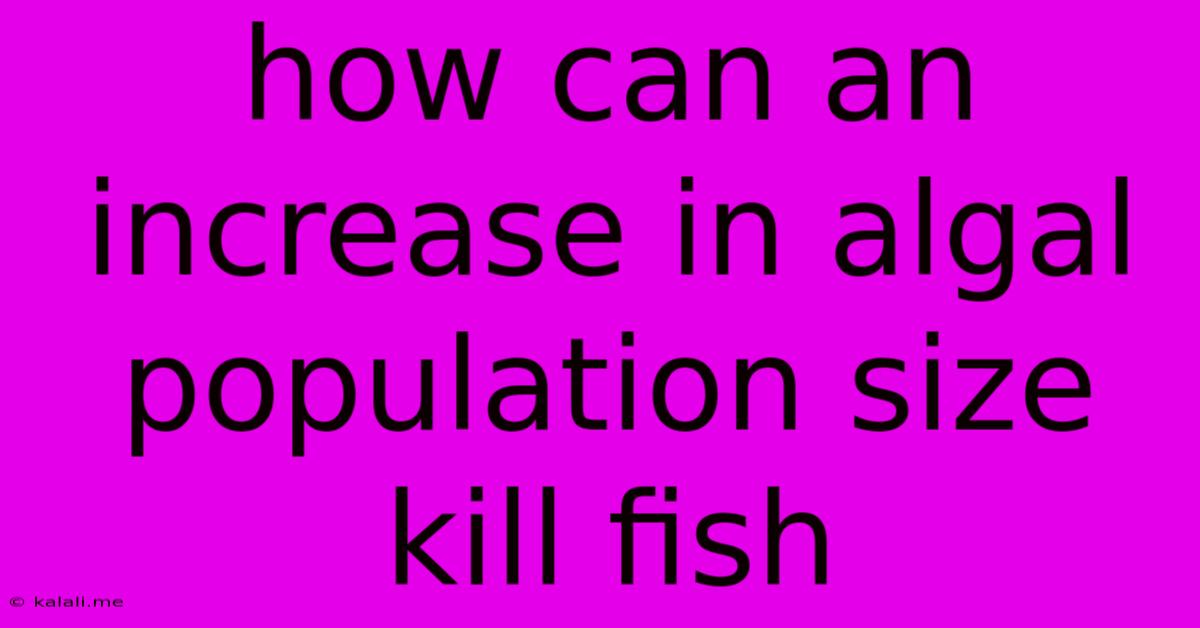How Can An Increase In Algal Population Size Kill Fish
Kalali
May 10, 2025 · 3 min read

Table of Contents
How Algal Blooms Can Kill Fish: A Comprehensive Guide
Algal blooms, those sudden explosions of algae in water bodies, are a growing concern worldwide. While they can appear beautiful from afar, their impact on aquatic ecosystems, particularly on fish populations, can be devastating. This article delves into the various mechanisms by which increased algal populations can lead to fish kills. Understanding these processes is crucial for effective water quality management and conservation efforts.
The Mechanisms of Algal Bloom-Induced Fish Kills
Several interconnected factors contribute to fish mortality during algal blooms. It's rarely a single cause, but rather a combination of these harmful effects:
1. Oxygen Depletion (Hypoxia and Anoxia)
This is arguably the most significant cause of fish kills associated with algal blooms. Algae, like all living organisms, require oxygen for respiration. However, as the algae die and decompose, a massive amount of organic matter accumulates in the water. This organic matter fuels the growth of bacteria, which consume large quantities of dissolved oxygen during their decomposition processes. This leads to hypoxia (low oxygen levels) and eventually anoxia (complete absence of oxygen) in the water, suffocating fish and other aquatic life. The severity of oxygen depletion depends on factors like the size of the bloom, water temperature, and water depth. Stagnant, shallow waters are particularly vulnerable.
2. Toxin Production (Harmful Algal Blooms - HABs)
Certain types of algae produce potent toxins that are harmful to fish and other animals. These blooms are known as Harmful Algal Blooms (HABs). These toxins can cause a range of effects, from gill irritation and impaired respiration to neurological damage and death. The specific toxins produced vary depending on the species of algae involved. Some common examples include microcystins (liver toxins), saxitoxins (neurotoxins), and brevetoxins (neurotoxins). These toxins can accumulate in the food web, affecting not just fish, but also other organisms and even humans who consume contaminated seafood.
3. Reduced Light Penetration
Dense algal blooms can significantly reduce the amount of sunlight penetrating the water column. This limits photosynthesis by submerged aquatic plants, reducing the overall oxygen production in the ecosystem. This further contributes to the oxygen depletion already caused by decaying algae, exacerbating the hypoxic conditions and increasing the risk of fish kills. The reduction in light also affects the growth and survival of other aquatic plants, disrupting the entire food web.
4. Changes in Water Chemistry
Algal blooms can alter water chemistry in several ways. For example, they can increase the pH of the water, making it more alkaline. They can also release ammonia and other harmful chemicals during decomposition, further stressing fish and other aquatic organisms. These changes can weaken fish, making them more susceptible to disease and other stressors.
5. Physical Effects
In some cases, the sheer biomass of an algal bloom can physically harm fish. Large clumps of algae can clog fish gills, hindering their ability to breathe. Algal blooms can also reduce water clarity, making it harder for fish to find food and avoid predators.
Conclusion:
The impact of increased algal populations on fish mortality is a complex issue resulting from a combination of oxygen depletion, toxin production, reduced light penetration, changes in water chemistry, and physical effects. Addressing algal blooms effectively requires a multi-pronged approach focusing on reducing nutrient pollution (eutrophication), improving water management practices, and implementing monitoring programs to detect and respond to HABs promptly. Protecting our aquatic ecosystems requires a holistic understanding of these intricate ecological interactions.
Latest Posts
Latest Posts
-
What Is 20 Percent Of 800 000
Jul 12, 2025
-
Words That Start With Y In Science
Jul 12, 2025
-
Prevent An Expressway Emergency By Merging Without
Jul 12, 2025
-
How Many Grams Of Sugar In A Pound
Jul 12, 2025
-
7am To 11am Is How Many Hours
Jul 12, 2025
Related Post
Thank you for visiting our website which covers about How Can An Increase In Algal Population Size Kill Fish . We hope the information provided has been useful to you. Feel free to contact us if you have any questions or need further assistance. See you next time and don't miss to bookmark.